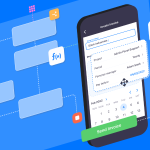Personalization in UI/UX: Semantic UI’s Evolution
- Post
- August 7, 2023
- Front-End Frameworks, Semantic UI, Web Development
- 0 Comments
In the ever-evolving landscape of User Interface (UI) and User Experience (UX) design, personalization has emerged as a pivotal element, reshaping how users interact with digital platforms. Semantic UI, a powerful front-end framework, has taken center stage, offering developers and designers a robust toolkit to unlock the potential of personalized UI/UX experiences. In this comprehensive exploration, we delve into the intricate world of Semantic UI, uncovering how it’s revolutionizing UI/UX personalization.
Unveiling the Power of Semantic UI Icons
Enhancing Visual Communication with Semantic UI Icons
Visual communication lies at the heart of engaging UI/UX design. Semantic UI Icons, a captivating component of the Semantic UI framework, transcend language barriers and add depth to user interactions. These icons aren’t mere embellishments; they serve as a universal language, conveying information efficiently and intuitively. From playful to professional, Semantic UI Icons offer a diverse range of symbols that cater to various design contexts, fostering seamless communication and interaction.
Leveraging Semantic UI Icons for Consistency and Accessibility
Consistency and accessibility are paramount in UI/UX design. Semantic UI Icons play a crucial role in maintaining a uniform design language across different platforms and devices. With a carefully curated collection of icons, designers can ensure that users experience a cohesive visual journey. Furthermore, Semantic UI Icons are thoughtfully designed with accessibility in mind, accommodating diverse user needs, and contributing to a more inclusive digital landscape.
Semantic UI CDN: Accelerating Performance and Accessibility
Unifying Design and Performance through Semantic UI CDN
A high-performing UI/UX isn’t solely about aesthetics; it’s about delivering a seamless experience. Semantic UI CDN (Content Delivery Network) steps up to the plate, offering an efficient way to integrate the framework into projects. By utilizing a globally distributed network of servers, Semantic UI CDN reduces latency and accelerates loading times, ensuring that users can access content swiftly from anywhere in the world. This marriage of design and performance creates a harmonious user journey that keeps visitors engaged.
Enabling Accessibility Through Semantic UI CDN
Web accessibility is a fundamental principle that shapes modern design practices. Semantic UI CDN reinforces this commitment by enabling developers to deliver accessible experiences effortlessly. By utilizing the CDN, developers tap into a framework that’s optimized for accessibility, laying the groundwork for a UI/UX that caters to users with disabilities. Semantic UI CDN’s compatibility with screen readers, keyboard navigation, and assistive technologies propels us toward a more inclusive digital future.
Crafting Dynamic UI with Semantic UI-CSS Integration
Harmonizing Design and Functionality with Semantic UI-CSS
A successful UI/UX hinges on the interplay between aesthetics and functionality. Semantic UI-CSS integration seamlessly intertwines these two aspects, allowing designers and developers to create dynamic interfaces that captivate and perform. The versatility of Semantic UI-CSS empowers teams to build intricate layouts, responsive designs, and interactive elements that adapt flawlessly to varying screen sizes and devices.
Navigating the Semantic UI-CSS Framework
Navigating the Semantic UI-CSS framework might seem like a complex endeavor, but its structured syntax and well-documented components make the journey remarkably intuitive. The framework’s modular nature fosters efficient development, enabling teams to cherry-pick components that align with their project requirements. From typography to grids, Semantic UI-CSS provides a treasure trove of tools that expedite the UI/UX design process.
Final Words Line: Personalization Elevated with Semantic UI
In a digital landscape where user-centricity reigns supreme, Semantic UI emerges as a beacon of innovation, ushering in an era of personalized UI/UX experiences. Through the power of Semantic UI Icons, the efficiency of Semantic UI CDN, and the dynamism of Semantic UI-CSS integration, designers and developers find themselves equipped with an arsenal of tools that enable them to craft interfaces that resonate deeply with users. As we embrace the limitless potential of personalization, Semantic UI stands tall, bridging the gap between imagination and implementation.
Commonly Asked Questions
Q1: How does Semantic UI Icons contribute to better user engagement?
A1: Semantic UI Icons transcend language barriers, offering a visual language that enhances communication and engagement, making the user experience more intuitive and captivating.
Q2: Can I customize Semantic UI Icons to match my brand’s aesthetic?
A2: Absolutely! Semantic UI Icons can be customized to align with your brand’s visual identity, ensuring a seamless integration that reinforces your brand’s personality.
Q3: Why is Semantic UI CDN crucial for web performance?
A3: Semantic UI CDN accelerates loading times and reduces latency by distributing content globally, resulting in a faster, more responsive user experience.
Q4: How does Semantic UI-CSS streamline responsive design?
A4: Semantic UI-CSS offers a modular framework with responsive design baked in, enabling developers to create interfaces that adapt seamlessly to various screen sizes and devices.
Q5: Is Semantic UI suitable for beginners in UI/UX design?
A5: Yes, Semantic UI’s well-documented components and structured syntax make it accessible for beginners, offering a smooth learning curve for those entering the world of UI/UX design.




